
When you ask architect Philip Beesley to speak about his latest projects, the answer covers a lot of ground. Mindfully, and sometimes enigmatically, he waxes poetic on the inspiration and processes behind his responsive 3D creations. Beesley, who was classically trained in art and architecture, merges the two fields with unparalleled grace. Spanning four decades, his portfolio adds to Canada’s skyline, but also to an overarching conversation on what is art, what is architecture, and what constitutes a living thing.
Beesley’s ideas are of the blue-sky variety. His projects reflect this in vivid, visceral forms. “I find myself increasingly using the word ‘living’ to describe the act of design,” he says. “Living, not so much as an evocative quality, but as a literal dynamic in which many things are coupled together, and connect and refresh, and regenerate and renew each other.” This cycle of life informs his work in myriad ways. The sinewy limbs and digits of his sculptures—replete with AI and synthetic biologies—react, respond, and interact with the viewer. “Part of the work is involved with biomimetics, with emulating life, and with learning from nature, and part of it is working rather seriously with attempting to gather the ingredients together, so the systems we are using can move toward literally being alive,” says Beesley.
A professor at the University of Waterloo, he also heads Philip Beesley Architect Inc. and Living Architecture Systems (LAS) based in Toronto, a hub of collaboration linking the work of engineers, futurists, designers, and psychologists. LAS is a testing ground for the architecture of the future. What if buildings could respond to their inhabitants, make the environment more comfortable, even repair themselves? Beesley’s role in this quest is equal parts hands-on tinkerer and conceptual visionary. In what could be a sterile, cold project, Beesley infuses an aura of unadulterated emotion and doe-eyed awe. “There is something so delicious in being able to participate, and to be a part of immeasurably complex things, to play and roll down a hill and make yourself dizzy, and see how something can be vulnerable, and affect other things,” he says. Within his architectural design practice, Philip Beesley, Aegis/Noosphere, Royal Ontario Museum, 2018. Delicate steel and acrylic are layered for strength, but use minimal material. The structure holds vessels of oil and prototype cells that produce chemical “skins”, which might, in the future, become the DNA of self-renewing buildings.he also cites concepts of alterity and dissociation, romanticism and genesis, along with the more expected areas of research.
Beesley’s kinetic sculptures are the finely honed results of knowing his materials at the nano level and exploiting their abilities. He works right at the tipping point, taking things as far as possible and layering the material, literally and figuratively, with his own artistic sensibilities. “I find myself increasingly trying to follow design paradigms in which, rather than making something tough, I try to make something as precarious as possible,” he says. The act of building these rather behemoth environments takes time and much hands-on work using every tool available from grassroots drawings and mechanics to injection moulding and 3D printing.
Beesley recently wrapped a show entitled “Transforming Space” at the ROM, featuring two immersive sculptures (or “living labs”, as he calls them), and Aeriform, a couture dress made in collaboration with Dutch fashion designer Iris van Herpen, who has become an important collaborator and friend in recent years. Van Herpen was inspired by Beesley’s groundbreaking exhibit “Hylozoic Ground” at the 2010 Venice Biennale, where he represented Canada. Her otherworldly Hybrid Holism collection was sparked by Beesley’s ethereal installations.
Each of his sculptures is rife with Mylar fronds, which activate microprocessors and sensors that adapt and learn as they gather intelligence from those around them. The AI systems are “programmed with a curiosity-based algorithm, causing the system to constantly search and find new patterns of behaviour.” It’s an intriguing—if not downright humbling—experience to interact with these enveloping pieces, which also emit sound and light in response to outside stimuli. They have a presence bordering on consciousness, taking on familiar forms reminiscent of butterflies, snow-flakes, or birds. Soon, he hopes, these living labs will be robust enough to withstand stronger forces, scaling up in size and standing on their own feet in the great outdoors. Beesley may not be your typical bricks-and-mortar architect, but he certainly moves the earth and reaches the sky all the same.
